The MOSFET (Metal Oxide Field Effect Transistor) is an active semiconductor device most widely used in Integrated circuits. It is a voltage-controlled device because the current between source and drain is controlled by the gate voltage. MOSFET is a unipolar device because the charge carriers that are responsible for current are either electron (in NMOS) or hole (in PMOS). It possesses high input impedance and is widely used for switching and amplifying purpose.
Basic structure of MOSFET
The MOSFET consists of four terminals namely source (S), drain (D), gate (G) and body (B). In most of the cases, the body is connected to the source, reducing it into a three-terminal device. The source and drain of a MOSFET are interchangeable. In n-channel device, the drain is at a higher potential than source whereas, in the p-channel device, the source is at a higher potential than drain. The source and drain are heavily doped as compared to substrate or body. The gate material is made up of metal or polysilicon which is heavily doped so that it is conductive. The gate electrode is electrically insulated from the substrate by a thin layer of silicon dioxide, SiO2.
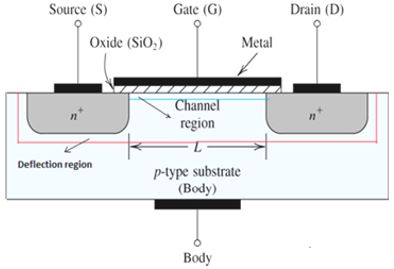
Characteristics of MOSFET
- Unipolar device
- Voltage-controlled device
- High input impedance
- High switching frequency
- Used for high power applications.
- Used for switching and amplification
Modes of operation
The operation of a MOSFET can be divided into 3 different modes.
1. Cut-off region – In this mode of operation, the transistor is in OFF state. There is no current in the MOSFET and it behaves like an open switch.
NMOS: VGS < Vth
PMOS: VSG < |Vth|
2. Linear/ triode/ohmic region – In this mode of operation, the transistor gets ON. The current flows through the MOSFET and it behaves like a voltage-controlled resistor.
NMOS: VGS > Vth
VDS < VGS – Vth
PMOS: VSG > |Vth|
VSD < VSG –|Vth|
3. Saturation region – In this region, the MOSFET acts as a closed switch.
NMOS: VGS > Vth
VDS >= VGS – Vth
PMOS: VSG > |Vth|
VSD >= VSG –|Vth|
Classification of MOSFET
MOSFET is classified into two types.

1. Depletion type
In this type of MOSFET channel is present from the beginning between drain and source.
a) N-channel (NMOS) Depletion type MOSFET
Structure – There is a p-type substrate with two highly doped n-type regions known as the source and drain on the two sides of the substrate material. These two highly doped n-type regions are connected by means of a conducting channel.
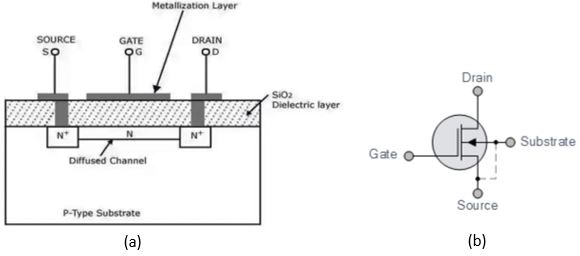
Operation of n-channel Depletion type MOSFET
⇒ VGS = 0 and VDS > 0
As soon as positive voltage is applied on the drain terminal, the electrons in the n-channel will get attracted towards the positive terminal. So electrons start moving from source to drain terminal and in this way, current starts flowing from drain to source in the MOSFET. If VDS is kept increasing, then current will continue to increase until all the electrons in the channel contribute to the flow of current. After that, the current will become constant.

⇒ VGS < 0
The negative voltage at the gate terminal will push electrons towards the substrate and at the same time holes in the p-type substrate will get attracted towards the oxide layer. Electrons will recombine with holes and the number of free electrons in the channel will decrease thereby reducing the amount of drain current.

⇒ VGS > 0
The positive voltage at the gate terminal will attract electrons which are minority carriers in the p-type substrate due to which the number of electrons in n-channel will increase. Effectively the drain current will increase in magnitude.
Drain characteristics of n-channel dMOSFET
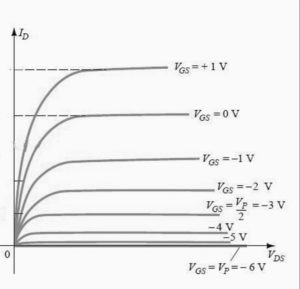
As the value of VDS is increased, the drain current ID will increase and after a certain voltage, the current will become constant. As the value of VGS becomes more and more negative, the value of drain current will reduce. The voltage VGS at which ID will become zero is called pinch-off voltage.
Therefore, we conclude that if a positive potential is applied on the gate, the drain current will increase in magnitude and with negative potential on the gate, the drain current will decrease with increasing VGS.
Transfer characteristics of n-channel dMOSFET
The transfer characteristic defines the relationship between the input and the output quantity. It gives the relationship between the drain current, ID and the voltage VGS for a fixed value of VDS.
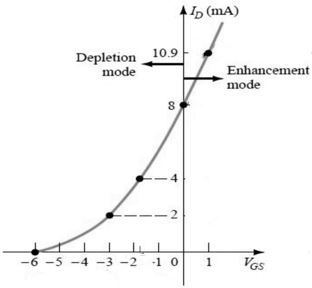
In this case, the value of ID for positive values of VGS is also obtained. Due to which the curve is extended to the right-hand side.
The region where VGS is positive is known as the enhancement region.
The region where VGS is negative is known as the depletion region.
b) P-channel (PMOS) Depletion type MOSFET
Structure – There is an n-type substrate with two highly doped p-type regions known as source and drain on the two sides of the substrate material. These two highly doped p-type regions are connected by means of a conducting channel.
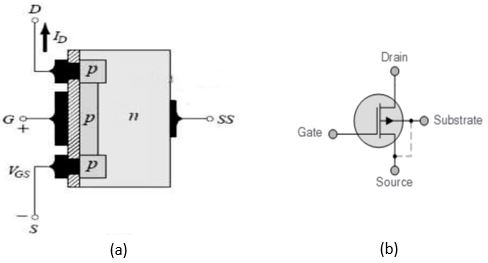
Operation of p-channel Depletion type MOSFET
⇒ VGS = 0 and VDS < 0
The holes in the p-type channel will get attracted towards the negative drain terminal. In this case, the conventional current will flow in the same direction i.e. from source to drain.
⇒ VGS > 0
Now the holes will be pushed towards n-type substrate and electrons will be attracted towards the channel. Hence, holes and electrons will recombine. As VGS is kept on increasing, the number of holes in p-channel will reduce and as a result current will decrease.
⇒ VGS < 0
The negative voltage at the gate terminal will attract holes which are minority carriers in the n-type substrate due to which the number of holes in p-channel will increase. Effectively the drain current will also increase.
Drain characteristics of p-channel dMOSFET
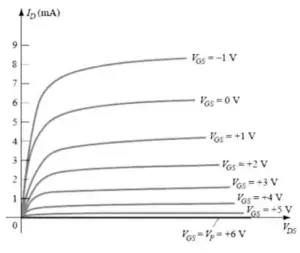
Transfer characteristics of p-channel dMOSFET
This curve is a plot of drain current and VDS at different VGS. If VGS is increased, the drain current ID will reduce and at the pinch-off voltage, ID will become zero.
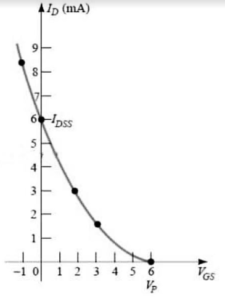
2. Enhancement type
In this type of MOSFET, initially, there is no channel present between drain and source. When the control voltage is applied between gate and source terminal, the channel is formed between the source and drain terminal. Therefore, in this type of MOSFET, the application of control voltage enhances the number of charge carrier near the oxide layer due to which channel is created. So, it is called enhancement type of MOSFET.
a) N-channel (NMOS) Enhancement type MOSFET
Structure – There are two heavily doped n-type regions known as source and drain doped into the p-type substrate. Initially, there is no connecting channel present between source and drain.
In the symbol, the line between drain and source is a dashed line which indicates the absence of channel in no bias condition.

Operation of n-channel Enhancement type MOSFET
⇒ If VGS =0 and potential is applied between source and drain
In this case, due to the absence of channel, there will be no flow of current in the MOSFET and it will remain in OFF-state.
⇒ VGS > 0 and VDS = 0
In this case, due to the positive potential at the gate, the holes which are near to the gate terminal will be pushed away and electrons which are minority carriers in the p-type substrate will get attracted towards the gate. But at lower VGS, these electrons will get recombined with the majority charge carriers. With increasing VGS, holes will be pushed more and more deeper into the substrate and electrons will be able to overcome the recombination with holes. They will move towards the gate terminal and will start accumulating near the oxide layer. Eventually, the inversion layer of free electrons will get created near the oxide layer. Now this inversion layer will act as a channel between source and drain. Thus, a channel is created between drain and source.
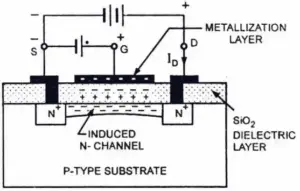
⇒ VDS > 0 and VGS > 0
In this case, current can flow through the channel. The value of VGS at which the inversion layer is formed is called threshold voltage, Vth. Below this voltage, no current flows through MOSFET.
Drain characteristics of n-channel eMOSFET
This curve is a plot of drain current and VDS at different VGS. As the value of VGS is increased, the drain current ID is also increased. When VGS < Vth the line is very close to the axis because the current through MOSFET is almost zero. Once VGS > Vth, the current starts to increase and ultimately there comes a point when pinch-off occurs and the current becomes constant. If we keep increasing the value of VGS, the channel gets wider that means the ID is increased but eventually pinch off occurs.
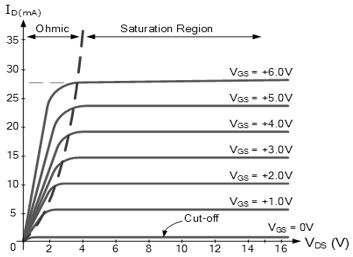
Transfer characteristics of n-channel eMOSFET
The transfer characteristics show the relationship between the input voltage, VGS and output current, ID at constant VDS.
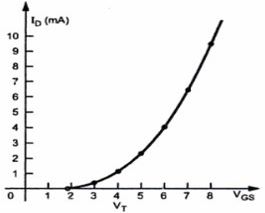
Below threshold Vth, the drain current is zero. Above Vth, the drain current, ID increases with an increase in the gate to source voltage, VGS.
b) P-channel (PMOS) Enhancement type MOSFET
Structure – There are two heavily doped p-type regions known as source and drain doped into the n-type substrate.
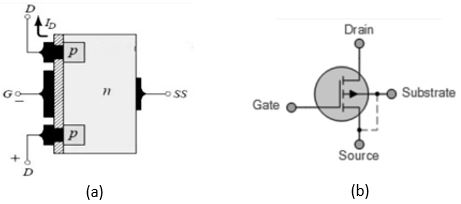
Operation of p-channel Enhancement type MOSFET
The operation is very similar to the n-type eMOSFET except in this case polarity of voltages and direction of flow of current will be reversed. Now the channel will be formed when the applied voltage VGS is negative or |VGS|> Vth and current starts flowing when potential VDS is applied between drain and source.

Drain characteristics of p-channel eMOSFET

In this case, VDS and VGS will be negative and current will flow from source to drain terminal. As VGS becomes more and more negative, drain current ID will increase and whenever VGS > Vth, MOSFET will operate in cutoff region.
Transfer characteristics of p-channel eMOSFET
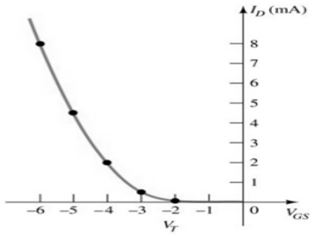
The transfer characteristic of p-type eMOSFET is the mirror image of n-type eMOSFET. The drain current is zero and the device remains off until VGS reaches -Vth. After this value ID increases in the reverse direction with a decrease in VDS.
Summary of different types of MOSFET
| MOSFET Type | VGS > 0 | VGS = 0 | VGS < 0 |
| N-channel depletion | ON | ON | OFF |
| N-channel enhancement | ON | OFF | OFF |
| P-channel depletion | OFF | ON | ON |
| P-channel enhancement | OFF | OFF | ON |
About Author
